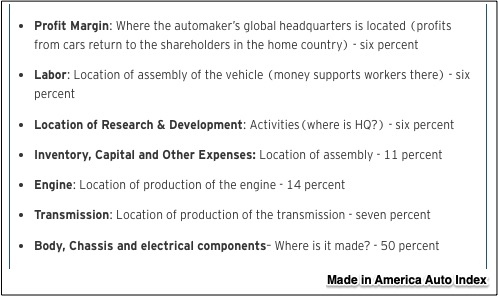
The Covid-19 Test That Does More With Less
August 9, 2020
What the CPI Is Hiding
August 11, 2020We could assume that a BMW from a South Carolina plant has more U.S. content than a Chevy Blazer that was assembled in Mexico. But, according to American University’s Made in America Index, it does not.
The Index uses seven criteria:
And these are the top 10 cars from a Made in America Index list of 100:
Made in America
The Definition
The definition of Made in America depends on where you look. For an item to have a Made in the USA label, the FTC (Federal Trade Commission) requires its “all or virtually all” standard. Slightly different, the rule for clothing and textiles says the fabric needed to be cut, sewn, and created in the U.S. But the yarn could come from somewhere else. Meanwhile, the Buy American Act (1933) mandates that U.S. governments have to buy U.S.made goods that are at least 50 percent made in America… if possible.
We can stop here and just say that what we mean by Made in America sounds clear until you look closely.
The Downside
Also until you look closely, the downside is tough to see. As economist Milton Friedman has explained, the jobs we lose are visible. But the cost elsewhere can be invisible.
In a new Peterson Institute report, researchers tell us that when governments Buy American, they overpay. On $236 billion of purchases, they could have saved $68 billion if imports were an alternative. Taking the next step, they concluded that the annual cost to the U.S. taxpayer could be more than $250,000 for each job that was saved. Their calculations included the inefficiencies created by buying less than optimal goods and the price hikes from domestic firms that had less competition.
Similarly, consumers pay more when tariffs protect American made goods. When Peterson Institute economists took a look at the impact of a 2009 tire tariff, they concluded that each of the 1200 saved jobs cost consumers $926,500 a year.
This was the math:

From: Peterson Institute for International Economics “U.S. Tire Tariffs: Saving Few Jobs at High Cost”
You can see why most economists support freer trade. But a 2016 study has made all of this more complicated.
The Downside of Freer Trade
The cost of freer trade with China to the low skilled worker has been considerable. Because of Chinese imports, certain U.S. regions have experienced higher unemployment and lower lifetime wages and labor force participation rates. Furthermore, since worker migration to other industries has been less than the experts expected, demand for unemployment, disability, and retirement benefits accelerated.
You can see below that the darkest brown areas had the largest exposure to Chinese imports:
Source: The China Shock: “Learning from Labor Market Adjustment to Large Changes in Trade,” NBER, January 2016
Our Bottom Line: Comparative Advantage
The economist who first explained comparative advantage, David Ricardo (1772-1823), said each nation should make the goods and services for which it has the lower opportunity cost and import what it does not produce. Because of those imports, consumers would enjoy lower prices and more variety. Benefitting also, exporters have larger markets that supported the efficiencies of economies of scale and ultimately, the entire world becomes more productive.
Still though, when a politician says “Buy American,” we have to look a bit more closely.
My sources and more: Peterson has a new paper on Made in America. It is worth a look. It is also worth checking on what BusinessInsider says Made In America means. Finally to see the current cost of saving 1800 jobs with a washing machine tariff, do look at this Bloomberg article. Please note that some of today’s sections were published in a past econlife. Also, after publication, I added the link to the Bloomberg article and edited the post slightly to improve clarity.
![econlifelogotrademarkedwebsitelogo[1]](/wp-content/uploads/2024/05/econlifelogotrademarkedwebsitelogo1.png#100878)







